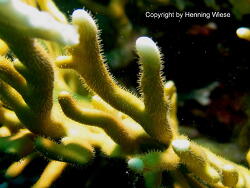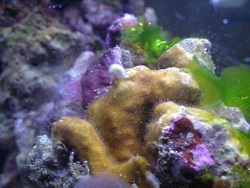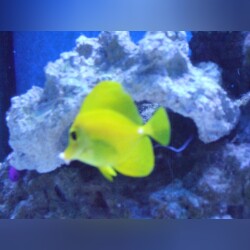Info
Synonyms:
Millepora cancellata Ehrenberg, 1834
Millepora clavaria Ehrenberg, 1834
Millepora reticularis Milne Edwards, 1860
Classification: Biota > Animalia (Kingdom) > Cnidaria (Phylum) > Hydrozoa (Class) > Hydrozoonolina (Subclass) > Anthoathecata (Order) > Capitata (Suborder) > Milleporidae (Family) > Millepora (Genus) > Millepora dichotoma (Species)
Even if the name suggests otherwise, fire corals are not corals, but belong to the hydrozoans, a class of cnidarians consisting of three orders, Hydroidea (hydroids), Siphonophora (state jellyfish) and Trachylina (subclass of cnidarians).
There are over 2,700 species in total, most of which live in the sea.
Fire corals are one of the main reef formers of our tropical coral reefs besides the well known hard corals (Scleractinia)!
Just like the reef forming hard corals, fire corals live in symbiosis with zooxanthellae, which provide them with up to 75% of the energy they need. The fire corals cover the remaining part by catching and energetically utilizing small zooplankton.
Caution!
Swimmers, snorkelers and divers should avoid fire corals and never touch them.
The nettle poison of the fire corals causes severe itching or burning and even blistering in humans.
Everyone knows the burning of nettles, similar skin reactions are dissolved by the nettle cells of the fire corals, in the worst case even a circulatory collapse can occur.
Similar to contact with state jellyfish, the affected skin areas can be moistened with 5% vinegar, later an itch-relieving and/or anti-allergic ointment can be applied to the skin.
Under no circumstances should the affected skin areas be wiped with freshwater or alcohol, as this will cause further nettle cells to burst and make the situation worse. Instead, the areas should be rinsed with sea water or vinegar. Vinegar deactivates the nettle cells. This prevents any further poison from entering the body. Afterwards, one strokes the body with a spatula (also knife back or EC card) to remove any remaining tentacles. The skin should then be cooled and an antihistamine gel or a 2% hydrocortisone ointment applied if necessary. If sweating, dizziness or palpitations occur, you should consult a doctor.
Actively poisonous animals have a poison apparatus which serves to introduce the toxic secretion directly into the organism of the prey or enemy. This is usually done by means of poison fangs with channels for the poisonous secretion (poisonous snakes), other jaw tools (black widow), spines (honey bee, yellow Mediterranean scorpion, lionfish) or nettle cells (sea wasp). Cone snails apply their toxin mixture via a sting, which is harpooned at prey or enemies. The toxin is produced and stored in venom glands of secretory epithelial cells or bacteria. In cnidarians, the poison remains in the individual cnidocytes. Actively poisonous animals are called "venomous" in English
Sources:
http://www.medizinfo.de/reisemedizin/gifttiere/meeresbewohner.shtml
https://www.biologie-seite.de/Biologie/Feuerkorallen







 spacediver
spacediver



























